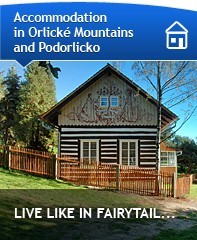Forgotten history
|
Informational material |
Many look up to pilgrimage places with humility and trust. They seek solace, understanding, healing and answers in them. Places in the landscape which bring together believers are an inseparable part of our history, through all of human existence. Various faiths met in the Region of the Eagle Mountains and foothills and have left their imprints here to the present.
When wandering through the Eagle Mountains and foothills you will notice dozens of Calvarias, crosses and statues, which will accompany you to larger sacred buildings, ranging from small churches, chapels, Way of the Crosses, parish churches to monumental churches and even Jewish synagogues and cemeteries. Significant European and local artists of their times and even local folk artists and artisans contributed to their construction and decoration. A pilgrimage beyond the borders to Poland’s Kladsko will expand your spiritual senses.
You will ascend to the imaginary heavens of the pilgrimage sight Homol along steps lined with balustrades with sculptural decoration and meditate in the small baroque church in the middle of the small cemetery. You will find a unique church and highly sought pilgrimage place in Neratov, in the tranquil corner of the Eagle Mountains, in a place predestined for prayer, meditation and meeting believers on the borderland of Bohemia and Kladsko. The uniqueness of this building structure makes visiting this pilgrimage destination very inspiring even for those who are interested in history and monuments as well.
Documents in the Jewish Museum and Karel Poláček monument will lead you in the footsteps of Judaism in the Region of the Eagle Mountains and foothills. You can also visit the Jewish cemetery or the synagogue, which reminds us of the almost five-hundred year history of the Jewish community in this region.
The Unity of the Brethren began writing its history in the foothill borderlands and its last bishop Jan Ámos Komenský, spent a part of his life here. Before his involuntary departure to Lešna Poland and then to other European cities, he wrote the first part of his significant work “Labyrinth of the World and Paradise of the Heart” here. You can even walk through the labyrinth, which grew from the ground on the site where the teacher of the nation wrote his book.

 Forgotten history (PDF)
Forgotten history (PDF)
![[w:trans]Nové okno[/w:trans].](/resource/img/public/external2.gif)





